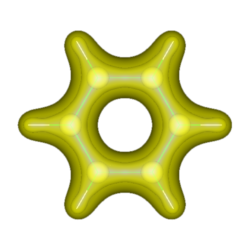actuatable modular structure
This describes a fundamental system of construction using discrete elements to form a repertoire of modules that interconnect to form assemblies having diverse geometries.
The component modules’ structure is geometrically elemental and made primarily of linear components. The materials making up the linear components have less than infinite elastic modulus. The linear elements and the modules they form, connect to one another under tension creating curvilinear structural networks having stored elastic potential energy. The system’s geometric outcomes range from discrete to quasicrystaline. These geometries may be tailored to many structural and mechanical applications. The combination of having the properties of stored elastic potential energy and diverse structural geometric outcomes will be advantageous when designing morphable/adaptable structures using high performance materials and/or discrete actuatable parts.
This system is well adapted to use carbon based composite materials and their future permutations, including nano composites. The structures created using this system could have application in terrestrial, space and aquatic environments. The system uses discrete linear elements and connectors as building blocks to form modules and in turn, multi-modular structures. The linear elements and connectors meet and interact to form physical structures that can function as adaptable behavioral networks. At the junctures where linear elements and connectors meet, a plurality of interface mechanisms allow information transfer and/or form reversible structural changes within the modules and/or multi-modular network structures. Structural changes within or between actuatable fundamental digital elements making up a network structure may lead to the controlled morphing of the greater structure. The fundamental digital elements are linear elements. The connectors facilitate the meeting/binding of digital elements one to another. The connectors and linear elements may act as structural and behavioral actuators that interface within the network structure they compose. This exemplary digital material’s physical and logical topology is integrated to form fundamental networks that may produce structural and behavioral dynamism.
The modules are analogous to the organic molecules that make up the matter of life. The diversity of organic matter’s shape and scale has its roots in the structure of the molecules that comprise it. Like these composite material modules, organic molecules are elastic structures. The elastic
energy stored in atomic bonds is potential mechanical energy. This stored energy enhances the molecule’s structural integrity and allows for structural changes in response to intramolecular interactions. This scenario could soon be made available macroscopically by advances in materials science. The system I propose is a vehicle for the creation of smart structures built from smart composite materials.
